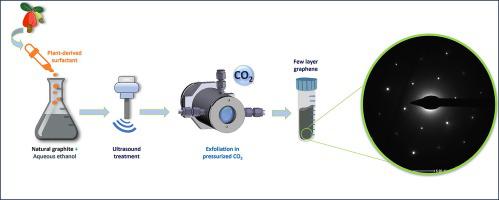Our official English website, www.x-mol.net, welcomes your feedback! (Note: you will need to create a separate account there.)
Few-layer graphene production through graphite exfoliation in pressurized CO2 assisted by natural surfactant
FlatChem ( IF 6.2 ) Pub Date : 2024-04-06 , DOI: 10.1016/j.flatc.2024.100656 Thuany G. Maraschin , Raiane V. Gonçalves , Marina C. de Vargas , Roberto Correa , Nara R.S. Basso , Griselda B. Galland , Eduardo Cassel
FlatChem ( IF 6.2 ) Pub Date : 2024-04-06 , DOI: 10.1016/j.flatc.2024.100656 Thuany G. Maraschin , Raiane V. Gonçalves , Marina C. de Vargas , Roberto Correa , Nara R.S. Basso , Griselda B. Galland , Eduardo Cassel

|
Graphene research has captivated researchers worldwide, propelling innovation across diverse industries. Through the liquid-phase exfoliation methodology of graphite powder, we have demonstrated a rapid route for obtaining few-layer and multi-layer graphene using a natural surfactant, cardanol. Aqueous phase exfoliation of graphite in the presence of cardanol as a surfactant was conducted to obtain pre-exfoliated graphite suspensions. The influence of different ultrasonication times, 10, 20, and 30 min, and contact times with the surfactant, 1 and 60 min, on the stability and concentration of dispersed exfoliated graphite was evaluated. Results indicate that ultrasonication for 20 min resulted in improved stability and reduced graphene flake sizes, making it suitable for scalable graphene production. Subsequently, the most stable dispersions of exfoliated graphite were subjected to CO-pressurized treatment. Promising results were obtained when employing cardanol at its critical micelle concentration. The graphene exhibited good structural quality, low defect density, and small stacking, with an average size of 15 nm, where 40 % of the stacked graphene was smaller than 5 nm. The findings provide valuable recommendations for the scalable production of graphene with multilayers and a few layers (FLG/MLG), using cardanol, a friendly surfactant, and a novel method of exfoliation utilizing supercritical CO. This technology represents an innovative approach, with potential applications in supercapacitors, solar cells, biosensors, polymer composites, and advanced materials.
中文翻译:

在天然表面活性剂辅助下,在加压二氧化碳中通过石墨剥离生产多层石墨烯
石墨烯研究吸引了世界各地的研究人员,推动了各个行业的创新。通过石墨粉的液相剥离方法,我们展示了一种使用天然表面活性剂腰果酚获得多层和多层石墨烯的快速路线。在腰果酚作为表面活性剂的存在下进行石墨的水相剥离以获得预剥离石墨悬浮液。评价了不同超声处理时间(10、20和30分钟)以及与表面活性剂的接触时间(1和60分钟)对分散膨胀石墨的稳定性和浓度的影响。结果表明,超声处理 20 分钟可提高稳定性并减小石墨烯薄片尺寸,使其适合大规模石墨烯生产。随后,对最稳定的膨胀石墨分散体进行CO加压处理。当使用临界胶束浓度的腰果酚时,获得了有希望的结果。石墨烯表现出良好的结构质量、低缺陷密度和小堆叠,平均尺寸为15 nm,其中40%的堆叠石墨烯小于5 nm。研究结果为使用腰果酚(一种友好的表面活性剂)以及利用超临界 CO 剥离的新方法,大规模生产多层和几层石墨烯 (FLG/MLG) 提供了宝贵的建议。该技术代表了一种创新方法,具有潜在的应用前景超级电容器、太阳能电池、生物传感器、聚合物复合材料和先进材料。
更新日期:2024-04-06
中文翻译:

在天然表面活性剂辅助下,在加压二氧化碳中通过石墨剥离生产多层石墨烯
石墨烯研究吸引了世界各地的研究人员,推动了各个行业的创新。通过石墨粉的液相剥离方法,我们展示了一种使用天然表面活性剂腰果酚获得多层和多层石墨烯的快速路线。在腰果酚作为表面活性剂的存在下进行石墨的水相剥离以获得预剥离石墨悬浮液。评价了不同超声处理时间(10、20和30分钟)以及与表面活性剂的接触时间(1和60分钟)对分散膨胀石墨的稳定性和浓度的影响。结果表明,超声处理 20 分钟可提高稳定性并减小石墨烯薄片尺寸,使其适合大规模石墨烯生产。随后,对最稳定的膨胀石墨分散体进行CO加压处理。当使用临界胶束浓度的腰果酚时,获得了有希望的结果。石墨烯表现出良好的结构质量、低缺陷密度和小堆叠,平均尺寸为15 nm,其中40%的堆叠石墨烯小于5 nm。研究结果为使用腰果酚(一种友好的表面活性剂)以及利用超临界 CO 剥离的新方法,大规模生产多层和几层石墨烯 (FLG/MLG) 提供了宝贵的建议。该技术代表了一种创新方法,具有潜在的应用前景超级电容器、太阳能电池、生物传感器、聚合物复合材料和先进材料。



























 京公网安备 11010802027423号
京公网安备 11010802027423号